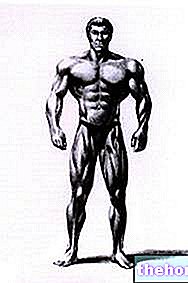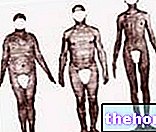Every day many people sign up in a gym confident and at the same time unaware and unaware of the sciences that will govern their future performance and results, they rely on instructors or in some cases the "guru" on duty and put the management in their hands. their body in the hope that these will transform it or at least bring them closer to the physical they have in mind.

This is why so many people rely on drugs (steroids and anoresizzants) to speed up or to achieve their goal and claim that of course it is impossible to have results.
In reality there is a path (difficult and long) but which is able to bring the individual to the maximum of the result which he can naturally pursue.
The science of biotypology and constitutional anthropology can really optimize a process of continuous improvement that passes through the various phases through initial evaluations, plicometries, monitoring and metabolic estimates.
The various constitutional schools
There are many schools that have dealt with this complex and varied subject, some from the point of view of temperament and others from the physical and constitutional point of view, still others starting from the oedogenic secretions of the glands and from nutrition.
Let's start this synthesized overview (to list them all would be impossible), of the various schools and thoughts in Europe and in the world:
The French school with the professors Bichat first and Jean Noel Halle then, described the temperaments in
Vascular, Muscular, Nervous and later enriched the concept with the insertion of the Bilious, Sanguineous and Pitutitoso type.
Later in 1908 to be precise, the French morphologist Sigaud distinguished the following individuals:
- Respiratory: characterized by the relative width of the trunk and the nasal-malar area.
- Digestive: characterized by the prominence of the abdominal area, large mouth, thick lips, prominent jaws.
- Muscular: it is characterized by the length of the limbs, a rectangular trunk, large muscle masses and small heads.
- Cerebral: They essentially have a slender trunk, thin bone, thin limbs, small body and large head.
There were many other theories such as that of the German anatomy professor Barke who simply divided the human being into two biotypes after carrying out various visceral anthropometric research on cadavers.
These were:
1) Gracile human type with hypoplastic organs
2) Wide overdeveloped human type with bulky organs.
Theodore Burgsch, another German, argued instead that the human body had to be framed on the basis of factors called Proportionality Indices such as:
- body weight
- stature
- pelvis width
- length of the upper and lower limbs
- relationship between thoracic perimeter and height
Ernesto Kretsschemer a psychiatrist instead dealt with the complex relationship between the psychic character and the "bodily habitus, divided the physicists into:
- Athenic: thin or slender
- Athletic: Muscular and proportionate
- Picnic: dense, dense, fat
- Dysplastic: rare, accessory, abnormal type.
In North America, however, Dr. Bryant identifies
- herbivore type: characterized by low thyroid activity during growth
- carnivorous type: characterized instead by a hyperfunction of the thyroid which increases its longitudinal profiles more.
In Russia, on the other hand, Saltikov and Ignatov identify, after various surveys of the internal and external measurements of the body, four biotypes which are:
- Stenoplastic: (thoracic)
- Euriplastic: (short abdominal)
- Mesoplastic: (muscular)
- Subplastic: (uncommon and not well defined type)
But the best interpretation of biotypes in my opinion and according to many authoritative insiders is Sheldon's interpretation which essentially identifies three with a scale of value to be attributed.
Sheldon identifies:
- Ectomorph: essentially long-limbed, frail, poor bone and muscle development and on a psychological level can be classified as a cerebrotonic
- Mesomorph: massive bone-muscular scaffolding, sturdy trunk, broad shoulders, hyper-framed and proportionate limbs, psychologically considered as a somatotonic.
- Endomorph: round and flaccid biotype, body height and width often approaching, abdomen prevails over chest, short limbs. Psychologically he is a viscerotonic.
Obviously it would be almost impossible to place a particular physicist in just one of these three categories, which is why the value scale was invented:
ex. Dorian Yates famous bodybuilder of the 90s could be a 3 7 2 where: 3 = fat component; 7 = muscle component; 2 = nerve component
Shawn Ray, on the other hand, another famous bodybuilder, but with a leaner and smaller physique could instead be classified as: 2 = fat; 6 = muscles; 3 = nerves
NB: The determination of one's biotype must take place through various evaluative analyzes and measurements and above all carried out by personnel expert in this method.
I repeat once again that the biomorphological determination is essential to assign the work in the gym, the most suitable "nutrition" and the most efficient integration.
I would like to say a few words about the work in the gym that the various biotypes should do, given that they still hear about all colors today.
Assuming that a subject will be evaluated several times over time to determine if the membership scale has changed, the training must have the following average requirements:
ECTO-MESOMORPHES WITH ECTOMORPHY VALUES> 2.5:
MESOMORPH WITH VALRI ECTOMORPHY <2.5:Polyarticular / monoarticular exercise ratio 5/0, over time (years) they can reach 2/1
Many meals throughout the day, more carbohydrates than proteins.
Rather rich recoveries especially at the beginning
Relaxation or stretching techniques
ENDO-MESOMORPHES:Polyarticular / monoarticular exercise ratio 4/1 and quickly to a 2/1, a competitive athlete even a 1/1
Average volume rapidly increasing over time
Shorter recoveries especially over time
More protein and fewer carbohydrates
Poly / mono exercise ratio = 2/1 at the beginning until 1/2 later
At least 40% of the exercises must be aerobic in nature
Low-fat, low-glucose, high-protein diet
Not very high recoveries
Concluding this article I would like to remind you once again that these evaluations, together with others of various kinds, are fundamental for the optimization of the membership of a gym or of a client of a personal trainer.
Neglecting all of this means spending money and time unnecessarily and should create some doubts about the level of preparation of your coach.
SEE ALSO: The somatotype, endomorph, mesomorph, ectomorph




























